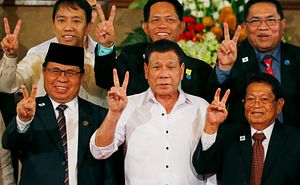In January 2019, residents of the Autonomous Region in Muslim Mindanao (ARMM) overwhelmingly voted to ratify the Bangsamoro Organic Law (BOL), paving the way for the creation of the Bangsamoro Autonomous Region in Muslim Mindanao (BARMM), which will replace the earlier ARMM. As his most significant legislation to date, the BOL may come to define Mindanao-native President Rodrigo Duterte’s legislative legacy. However, the region’s active terrorist groups remain a major obstacle to the realization of Duterte’s hope for a lasting peace for Mindanao.
The 2018 BOL was conceived specifically as part of the 2014 Comprehensive Agreement on the Bangsamoro (CAB) peace deal with the Moro Islamic Liberation Front (MILF) group that paved the way for their legitimization and power sharing in the governance of Bangsamoro. MILF had been active since the late 1970s, engaging in terrorism to compel the Philippine government to grant Bangsamoro independence for the region’s Moro people. Though MILF reinterpreted their grand strategy to be the achievement of autonomy — rather than independence — in 2010, it wasn’t until 2014 that they struck a permanent peace with the Philippine government.
CAB is individualized to MILF’s vision of greater autonomy in Bangsamoro, affording them direct and significant power sharing in governance of the region under BARMM. In exchange, the MILF will decommission their armed wing and relinquish their weapons. BARMM will be implemented by a coalition of MILF, the Moro National Liberation Front (MNLF), and incumbent ARMM officials as part of the Bangsamoro Transitional Authority (BTA) before elections scheduled for 2022. It is imperative that individual visions of BARMM governance in practice — held by MILF, the MNLF, and the government — be reconciled into a serviceable and constitutional reality in order to reduce the likelihood of dissatisfied members of MILF or the MNLF defecting to terrorist groups.
Demilitarization will be challenging, considering the local trust deficits stemming from memories of MILF violence before they relinquished terrorism. For example, the province of Lanao Del Norte rejected inclusion in BARMM under the second phase of the plebiscite. Although consistent with their earlier rejection of being included in ARMM, this also reflects a lingering distrust of MILF after a 2008 offensive into Lanao Del Norte led by MILF’s Commander Bravo. Some MILF commanders have also expressed reservations about BARMM disarmament, which could upset the fragile communal trust upholding BARMM demilitarization commitments. Communal reconciliation and trust-building will be important determinants of the BTA’s ability to demilitarize societies and stem illicit weapon proliferation.
However, it is important to consider that regional terrorism does not start or end with MILF. MILF is a breakaway group from the MNLF, who had engaged in terrorism until 1996, and MILF itself later splintered to form the Bangsamoro Islamic Freedom Fighters (BIFF). Additionally, the Islamic State (IS) and its regional partners such as the Abu Sayyaf Group (ASG) and the Maute Group are important constituents of terrorism in Mindanao that cannot be overlooked. Organizational instability, factionalism, and intersecting family and terrorist loyalties have all perpetuated and intensified Mindanao’s kaleidoscope of terrorism, muddying already indistinct boundaries between myriad groups, cells, and factions.
Mindanao has a long history of political violence, from the anti-colonial struggles of the past to the jihadist groups of today, which are in recent times fueled by a variety of violent extremism push and pull factors, including the financial allure of terrorism against the backdrop of widespread poverty and co-optation of the Moro people’s grievances of under-representation and marginalization, among numerous other factors. The resiliency of terrorism in Mindanao has seen new factions emerge and “defeated” groups regenerate, such as the resurgence of the Maute Group after their defeat in the 2017 Marawi offensive. Many of Mindanao’s terrorist groups, such as the ASG and BIFF, are now outliers relative to a global organizational life expectancy of less than a year.
These jihadist groups will not be assuaged by the provisions of BARMM. They have no intention to partake in this iteration of state-sanctioned self-governance in Bangsamoro, and the idea of establishing a lasting peace in Mindanao through BARMM alone cannot be reconciled with this reality. Unfazed by the plebiscite, jihadist groups continue engage in terrorism. For example, the ASG faction leverages Islamic State affiliation for their own independence agenda. Following the first phase of the plebiscite, ASG attacked the Cathedral of Our Lady of Mount Carmel in Jolo, an area thatwill ultimately be included in BARMM (due to ARMM voting to be incorporated into the BARMM). This is despite Jolo voting to reject inclusion, highlighting how ratification of BARMM is not necessarily indicative of an intraregional consensus. Much like the ASG, BIFF also desire full independence from the Philippines, and are behind a continued specter of violence across Bangsamoro, even after ratification of BARMM.
Though insulated from the BARMM peace process, terrorist groups are indivisible from important regional goals of demilitarization, inhibiting weapons proliferation, and communal reconciliation, and will remain structural impediments to the BTA’s success. Lessons learned from CAB could be utilized to extend the scope or provisions of the peace agreement to include a broader spectrum of violent extremists in the future. This could have a far more comprehensive impact on resolving many of the region’s terrorism push and pull factors. For example, extension of the MILF rehabilitation packages could potentially lift other violent extremists in Mindanao out of extreme poverty, inhibiting terrorist recruitment based on financial incentives and preventing conflict recidivism. As MILF was not the sole perpetrator of regional violence, a lasting peace for Mindanao cannot be predicated on a peace agreement with them alone. The path toward lasting peace in Bangsamoro and the wider Mindanao is only just beginning with the establishment of BARMM.
Mathew Bukit is Program Manager and Editor at the Asian Vision Institute (AVI). The opinions expressed are the author’s own and do not reflect the views of the Asian Vision Institute.

































